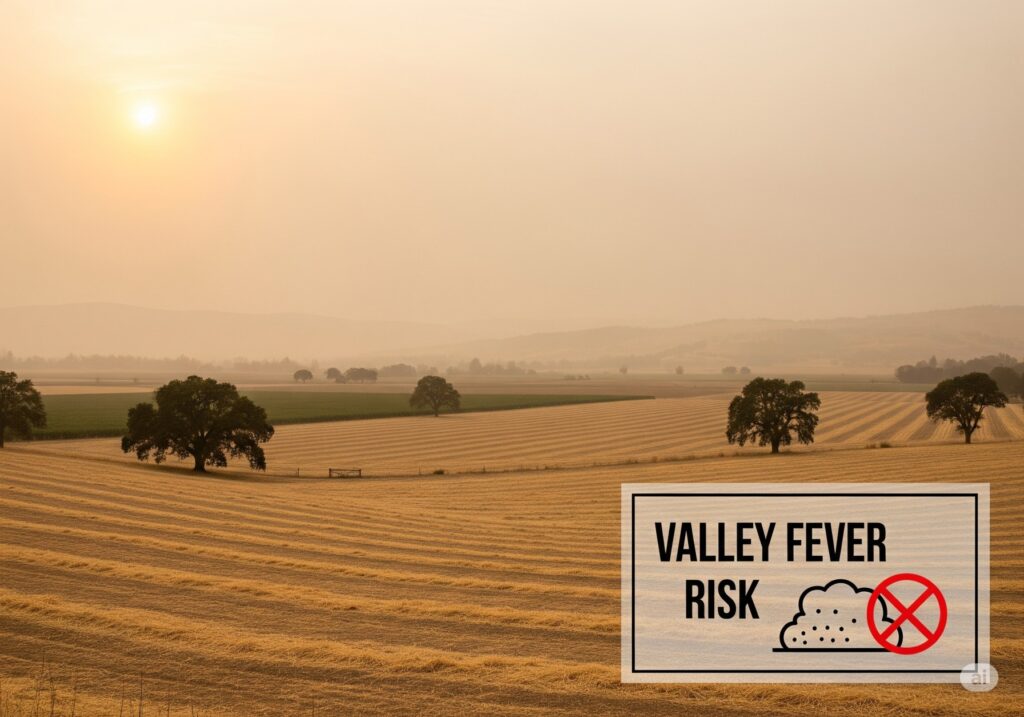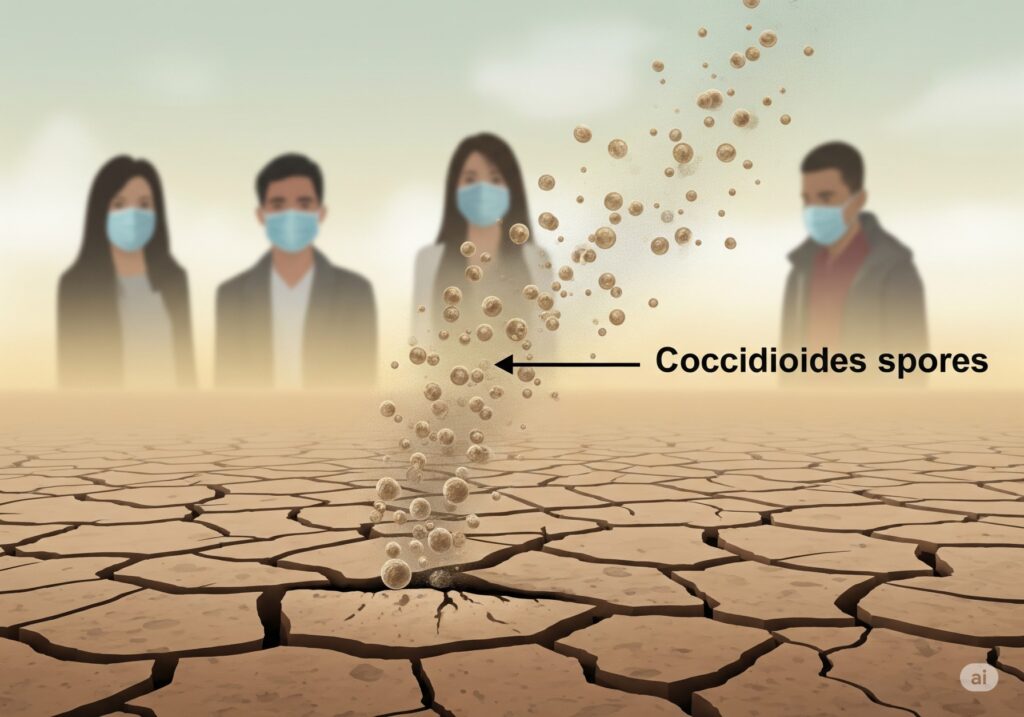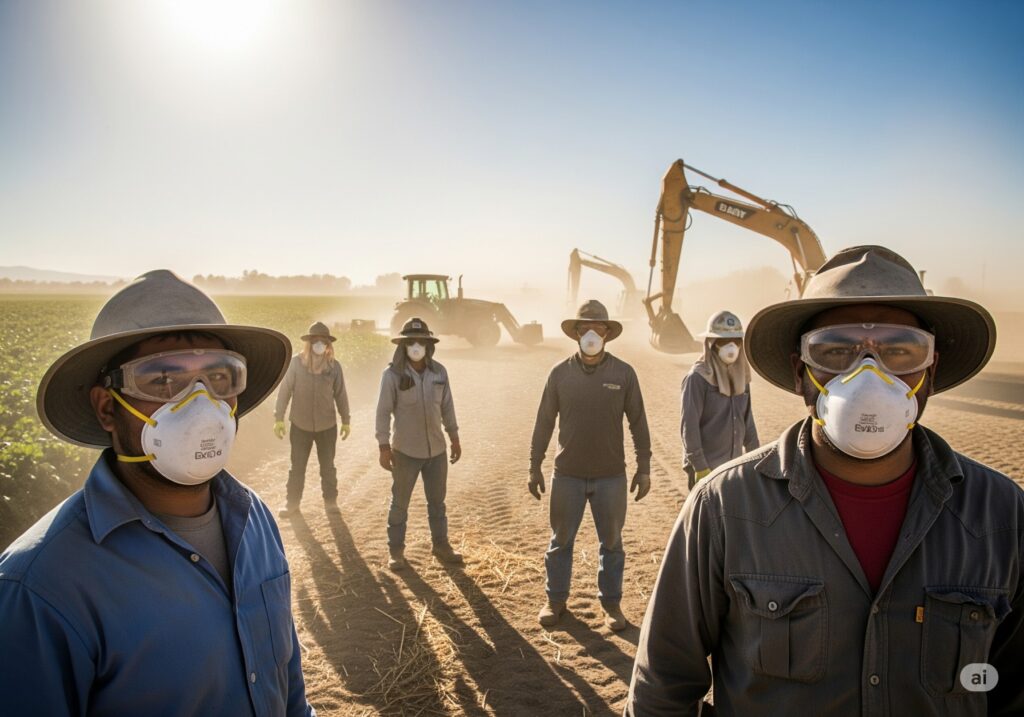
Valley fever California dust risk in Central Valley farmland
Valley fever California cases reach record highs. Find out the warning signs, risk factors, and prevention tips to safeguard your health.
Valley fever surges in California: All about the symptoms, risk factors, and prevention
California is seeing a sharp rise in Valley fever cases. Public health data show that the state recorded nearly 12,500 cases in 2024, the highest number on record. Early 2025 counts remain elevated, suggesting another high year. This trend worries clinicians, workers, and families across the state.
Valley fever, or coccidioidomycosis, is caused by inhaling spores of Coccidioides fungi. These spores live in dry soils. When wind, construction, or farming disturbs the ground, dust carries the spores into the air. People breathe them in. Some never get sick. Others develop flu-like illness. A small share develops severe disease. For basics, see the CDC Valley Fever page and the California Department of Public Health (CDPH) hub.
What is Valley fever?

Valley fever is primarily a lung infection. After exposure, symptoms usually appear within 1–3 weeks. Because it mimics a cold or flu, many people do not realize they have it without testing. Learn more about testing options on the CDC’s testing overview.
Common symptoms of Valley Fever
- Fever and cough
- Fatigue and headaches
- Chest pain or shortness of breath
- Night sweats or rash
These signs can be mild. Yet, in some patients, the infection lasts for months or spreads beyond the lungs. If symptoms persist, ask a clinician about Valley fever testing, especially after travel or work in endemic areas. See CDC symptoms.
Why are cases rising now?
Weather swings matter. Wet winters help the fungus grow in the soil. Later, hot and dry periods create dust that lifts spores into the air. Researchers and officials attribute the recent surge to these climate-driven wet-dry cycles and the expansion of suitable habitats. Read more in CDPH’s data dashboards and recent climate analyses.
In 2024, California hit a record number of cases. Through the first half of 2025, provisional reports remained high across the Central Valley and parts of the Central Coast. Local spikes have been noted in several counties. For current numbers, explore the CDPH provisional dashboard.
Where is Valley fever found?
In the U.S., Valley fever is most common in California and Arizona, with pockets across the Southwest and parts of Washington and other western states. The range can shift with climate and land use. The CDC map shows affected regions and notes that outbreaks can occur after dust storms or excavation. See CDC areas with Valley fever.
Who faces the highest risk?
Anyone can get Valley fever. However, the risk of severe illness is higher for:
- People who are pregnant or older adults
- People with weakened immune systems (e.g., due to certain medications or conditions)
- People with diabetes
- Outdoor workers exposed to dust (construction, agriculture, archaeology, military training)
- Residents and travellers during dusty seasons
CDPH and CDC both list these factors and recommend targeted precautions. See CDPH groups at risk and CDC risk guidance.
When to seek testing?
Do not ignore pneumonia-like symptoms. If you live in or have recently visited Central California or the Southwest and develop a persistent cough, fever, or chest pain, ask your clinician about Valley fever testing. Blood tests can confirm infection. Early diagnosis helps guide care and avoid unnecessary antibiotics. Start with the CDC testing overview.
Practical prevention tips
You cannot eliminate risk entirely, but you can reduce exposure:
- Check dust forecasts. During dust storms, stay indoors and close windows.
- Limit digging, yard work, or off-road activities in very dry soil.
- If dusty work is unavoidable, wear a fit-tested N95 respirator and dampen soil to keep dust down.
- Use indoor air filtration during high-dust periods.
- Clean skin injuries well to avoid secondary infections.
These measures come from the CDC’s prevention guidance. Workplaces should also follow dust-control rules and provide respirators when needed. CDC prevention and CDPH prevention tips.
Extra steps for travelers and outdoor enthusiasts
Planning a trip to California’s Central Valley, desert parks, or the Central Coast backcountry? Wear a mask on windy trail days. Avoid kicking up dust. Choose paved or dampened campsites when possible. CDC’s Yellow Book notes that preventive antifungal medication may be considered only in select high-risk circumstances under medical guidance. See the CDC Yellow Book entry.
Treatment and recovery
Many people recover without medication in a few weeks to months. However, those with severe symptoms or higher risk may need antifungal drugs such as fluconazole or itraconazole, typically for several months. Complicated or disseminated disease may require longer therapy or intravenous amphotericin B. Discuss options with your clinician and review the CDC’s treatment guidance. See CDC treatment and clinical overview.
Living with Valley fever
Fatigue can linger. So, pace yourself. Hydrate well. Follow up with your care team. If symptoms worsen—especially headaches, stiff neck, new skin lesions, or joint swelling—seek care promptly. These can signal a more serious disease.
County trends and local resources
Case numbers are highest in the Central Valley. Counties such as Kern, Fresno, Kings, and Tulare report the largest share each year. Kern County, for example, often accounts for nearly one-third of California’s Valley fever cases. Local health departments there run awareness campaigns and issue alerts during dusty seasons.
- Kern County Public Health: kernpublichealth.com
- Fresno County Public Health: fresnocountyca.gov/departments/public-health
- Tulare County Health & Human Services: tchhsa.org
Checking these sites helps residents find testing locations, safety updates, and prevention workshops.
Worker protections and safety tips

California law requires employers in construction, agriculture, oil extraction, archaeology, and military training sites to minimize dust exposure. Employers should:
- Provide respirators (N95 or higher) when dust levels are high
- Offer Valley fever training so workers recognize symptoms early
- Use soil-wetting, covering, or dust-control equipment at worksites
- Support workers seeking medical evaluation after exposure
Cal/OSHA has specific rules for outdoor work in dusty areas. For details, see Cal/OSHA Valley Fever guidance.
Key takeaways
- California had a record year for Valley fever in 2024, and 2025 remains elevated.
- Symptoms often look like the flu. Testing matters.
- Dust control and N95 use reduce exposure.
- High-risk groups should be extra cautious.
- Early treatment helps prevent complications.
For real-time trends, bookmark the CDPH Valley Fever dashboards and follow your county health department for local alerts.
Note: This article links to authoritative public-health resources and summarizes current evidence. For personal medical advice, consult a licensed clinician.





